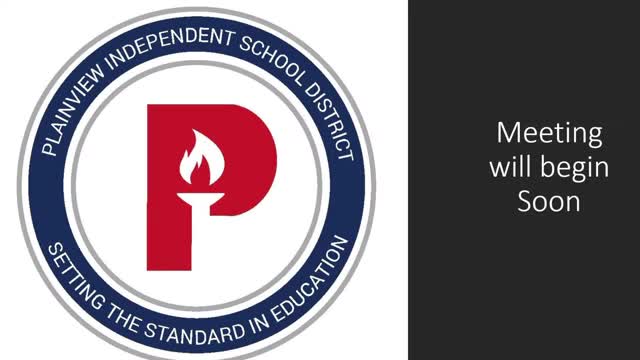School Board adopts 2024-2025 tax rate amid legislative funding concerns
August 30, 2024 | PLAINVIEW ISD, School Districts, Texas
This article was created by AI summarizing key points discussed. AI makes mistakes, so for full details and context, please refer to the video of the full meeting. Please report any errors so we can fix them. Report an error »

On August 29, 2024, the Plainview Independent School District (PISD) Board convened for a special called meeting, where key financial decisions were made regarding the upcoming tax rate and budget for the 2024-2025 school year. The meeting began with a prayer and the Pledge of Allegiance, setting a collaborative tone for the discussions that followed.
One of the primary agenda items was the approval of the tax rate for the upcoming year. The board proposed a tax rate of 1.3238 per $100 valuation, which includes a maintenance and operation rate of 0.8238 and an interest and sinking rate of 0.5. This rate represents a decrease from the previous year, attributed to state-mandated tax rate compression. However, concerns were raised regarding the state’s commitment to compensating for the revenue loss, as the legislature has yet to release promised funds despite holding over $30 billion.
Board members expressed apprehension about the ongoing negotiations surrounding school vouchers, which could further impact funding for public education. The discussion highlighted the tension between state financial commitments and the realities faced by local school districts. Ultimately, the board unanimously approved the proposed tax rate, signaling a step forward in their financial planning for the year.
Following the tax rate discussion, the board moved on to consider the budget for the 2024-2025 school year. While specific details of the budget were not elaborated upon in the transcript, the approval of the tax rate is a critical precursor to finalizing the budget, as it directly influences the district's financial resources.
In conclusion, the PISD Board's meeting underscored significant financial decisions that will shape the district's operations in the coming year. The approved tax rate reflects both a response to legislative changes and a cautious optimism about future funding, as the board navigates the complexities of state education policy and its implications for local schools. The next steps will involve finalizing the budget, with ongoing attention to the broader financial landscape affecting public education in Texas.
One of the primary agenda items was the approval of the tax rate for the upcoming year. The board proposed a tax rate of 1.3238 per $100 valuation, which includes a maintenance and operation rate of 0.8238 and an interest and sinking rate of 0.5. This rate represents a decrease from the previous year, attributed to state-mandated tax rate compression. However, concerns were raised regarding the state’s commitment to compensating for the revenue loss, as the legislature has yet to release promised funds despite holding over $30 billion.
Board members expressed apprehension about the ongoing negotiations surrounding school vouchers, which could further impact funding for public education. The discussion highlighted the tension between state financial commitments and the realities faced by local school districts. Ultimately, the board unanimously approved the proposed tax rate, signaling a step forward in their financial planning for the year.
Following the tax rate discussion, the board moved on to consider the budget for the 2024-2025 school year. While specific details of the budget were not elaborated upon in the transcript, the approval of the tax rate is a critical precursor to finalizing the budget, as it directly influences the district's financial resources.
In conclusion, the PISD Board's meeting underscored significant financial decisions that will shape the district's operations in the coming year. The approved tax rate reflects both a response to legislative changes and a cautious optimism about future funding, as the board navigates the complexities of state education policy and its implications for local schools. The next steps will involve finalizing the budget, with ongoing attention to the broader financial landscape affecting public education in Texas.
View full meeting
This article is based on a recent meeting—watch the full video and explore the complete transcript for deeper insights into the discussion.
View full meeting
